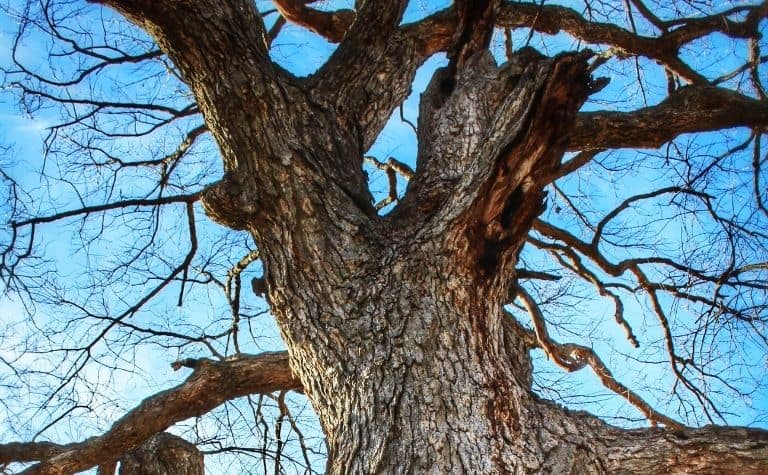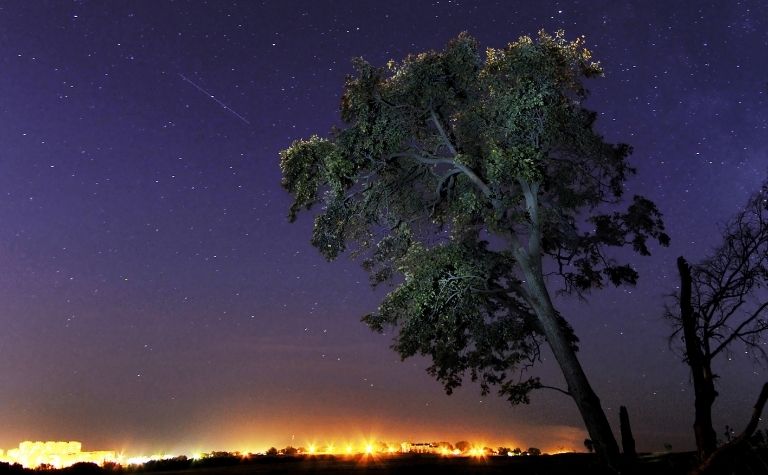It is the mighty evergreen ash tree that lies at the center of the cosmos, providing structure and order to all the realms in the universe.
Yggdrasil is one of the most important concepts of Norse mythology, a sacred symbol that represents the essence of existence and its many meanings.
Known as the Norse tree of life, Yggdrasil is central to key themes that run throughout Norse mythology, most notably: life and death, order and chaos, and the cyclical nature of existence.
Just as Yggdrasil is the essence of the universe, so too does it figure prominently in its destruction and rebirth.
The significance of Yggdrasil cannot be overstated and it is quite possibly the most important symbol in Norse mythology, with far-reaching meanings that apply to many key aspects of life.
Most importantly, this sacred ash tree is the one constant in the storyline of the cosmos, starting from creation and spanning all existence, withstanding the ravages of Ragnarok and seeding a new beginning. Here’s how.

How is Yggdrasil Pronounced?
Like many words and phrases that are translated from their original Old Norse forms, Yggdrasil would appear to pose a challenge to even the most accomplished of linguists at first blush.
But its pronunciation is rather straightforward in spite of the fact that the first five letters, and seven out of its total of nine letters, are all consonants.
There are three syllables in the word Yggdrasil. Here is how to pronounce them:
- Ygg – pronounced “eehg”
- Dra – pronounced “drah” (the “r” can be rolled for a more authentic sound)
- Sil – pronounced “seal”
As far as the origin of the word, experts seem to be in agreement that the word Yggdrasil is a tribute to Odin, the leader of all Norse gods, and comes from Old Norse phrases:
- Yggr, meaning “terrible” and representing one of many nicknames given to Odin by the ancient Norse people
- Drasill, meaning “horse”
Taken together, Yggdrasil is a direct reference to Odin’s pursuit of unlocking the secrets of ancient tunes by hanging himself from the branches of the Norse tree of life for nine straight days.
The name has come to symbolize Odin, as the weary but triumphant rider, and Yggdrasil as his trusted steed. [2] (Also see Do People Still Believe In Odin?)
What is the Meaning of the Yggdrasil Tree Symbol?
Yggdrasil is one of the most powerful and deeply revered symbols in all of Norse mythology.
The Norse tree of life has many meanings and many are tied to themes relating to life and existence as seen through the eyes of the ancient Norse people. [3]
The nine realms of the cosmos are said to lie within Yggdrasil’s branches and roots and therefore, it is an almighty force holding the universe together.
Other important meanings include:
- The interconnectivity of the different parts of the cosmos, such as the mortal realm and the afterlife
- The natural order existing within the universe
- The roles of fate and destiny in the Norse view of life
With its substantial symbolic significance in Norse culture and religion, Yggdrasil is a common fixture in spiritual and decorative motifs and objects.
As far as depictions of Yggdrasil and its symbolic representations, they commonly consist of the following visual elements:
- a lush and expansive canopy of branches extending far and wide
- a thick and robust trunk
- sturdy roots that counterbalance the branches in terms of size and proportion [4]
Renderings of Yggdrasil often shape the branches above and roots below so as to encircle the entire tree.
This not only emphasizes the cyclical view of existence that is prevalent in Norse mythology but also lends itself to the notion that Yggdrasil serves as the axis mundi, that which binds the entire universe, connecting all the different realms, most notably the heavens, the earth, and the underworld. [5]
Also, see Valhalla vs Asgard: What’s the Difference?

What is the Story of the Yggdrasil Tree in Norse Mythology?
According to Norse mythology, Yggdrasil not only lies at the center of the universe, but it also provides stability and structure for that which lies within it, including all nine realms and their inhabitants.
It is among Yggdrasil’s vast expanse of branches and roots that the worlds of the Aesir and Vanir gods, humankind, and the giants, are situated and order among them maintained until that is, the arrival of Ragnarok. (Also see The Giants of Norse Mythology)
The Norse tree of life, as Yggdrasil is also known, figures prominently in many of the Norse people’s mythological tales. [6]
Even well before the Vikings came along during the Middle Ages, Yggdrasil was a deeply revered symbol playing a central role in various narratives concerning the ancient Scandinavians’ existence and place in the cosmos.
For instance, Yggdrasil is synonymous with the Norse view that the existence of the cosmos is cyclical in nature, meaning that there is birth, followed by growth, then death, and finally rebirth.
There are other major themes that are prevalent throughout Norse mythology and cosmology involving Yggdrasil, including most notably:
- Fate and destiny as embodied by the three Norns – Urda (past), Verdandi (present), and Skuld (future) – who together determine the futures of all beings, even the gods. Odin the all-father himself learned that once destinies have been foretold and carved into the bark of Yggdrasil in the form of ancient runes, no power in the universe can change or reverse them.
- Knowledge and enlightenment as represented by Odin’s torturous nine-day ordeal, hanging from the branches of Yggdrasil while self-impaled by his own spear, all for the sake of unlocking the mysteries of ancient runes.
- With respect to the Norse view of creation, Yggdrasil is a continuation of strong tree-centric themes as Norse myths describe the first humans being formed from trees: a man from an ash tree and a woman from an elm tree.
Even the beasts and creatures that dwell within Yggdrasil add to the story of the Norse tree of life:
- The fragility of order, as exemplified by the perpetual conflict between a nameless eagle that lives atop Yggdrasil, and a malevolent serpent named Nidhogg dwelling within its dark depths, constantly gnawing on one of its roots.
- The two creatures exchange insults through a squirrel that scurries back and forth between them and passes along their messages. [7]
The story of Yggdrasil is complex, multi-layered, and full of fascinating figures and intriguing storylines. In so many ways, it mirrors Norse mythology and the people who looked to it for answers. (Also see Is the Norse Religion Still Practiced?)
How is the Yggdrasil Tree Related to Ragnarok?
As vital of a role that Yggdrasil plays in maintaining order in the cosmos, it is an equally indispensable part of the Ragnarok storyline.
Although details are a bit hazy as far as Yggdrasil’s specific fate during the cataclysmic battle pitting Odin and his einherjar against Fenrir and the Jotnar, what is clear is that once all the post-Ragnarok dust settles, a new world order is born, and it emerges from Yggdrasil:
- In the aftermath of Ragnarok, two human survivors emerge from the inner confines of Yggdrasil where they had taken shelter
- This husband and wife (named Lif and Lifbrasir) will go on to re-populate the world
- Although Odin, Thor, and most Norse gods do not survive Ragnarok, the new world they leave behind will be free from chaos [8] (Also see Do Norse Gods Age and Die?)
One of the major themes involving Yggdrasil is the cycle of existence and it is in this regard that its role in the Ragnarok narrative, as the protector of the new world order, is both an end and a beginning.
The Yggdrasil tree in ancient Scandinavian sources
One source the Yggdrasil tree is mentioned in is the Voluspa,
I know an ash tree that stands, called Yggdrasil
A tall tree, sprinkled with white mud;
Thence come the dews that run into valleys,
Forever it stands green over the Urdarbrunn
Another writer describes the tree this way,
The ash is the greatest and best of all trees. Its limbs stretch over the entire world and rise above heaven. Three roots of the tree hold it up and stretch out widely.
One is among the aesir, the second among the frost giants, where Ginnunga gap used to be, the third stands over Niflheim.
Under that root is Hvergelmir, and Nidhogg gnaws the roots from below. Under that root which turns toward the frost giants is the Mimisbrunn…
The third root of the ash stands in heaven and under that root is that well which is very holy and is called the Urdarbrunn; there the gods have their place of judgment. Each day the aesir ride up there on Bilrost.
Conclusion
As far as important symbols of Norse mythology are concerned, there may be none more significant and deeply revered than Yggdrasil, the sacred ash tree.
References:
[1] Source
[2] Source
[3] Source
[4] Source
[5] Source
[6] Source
[7] Source
[8] Source
